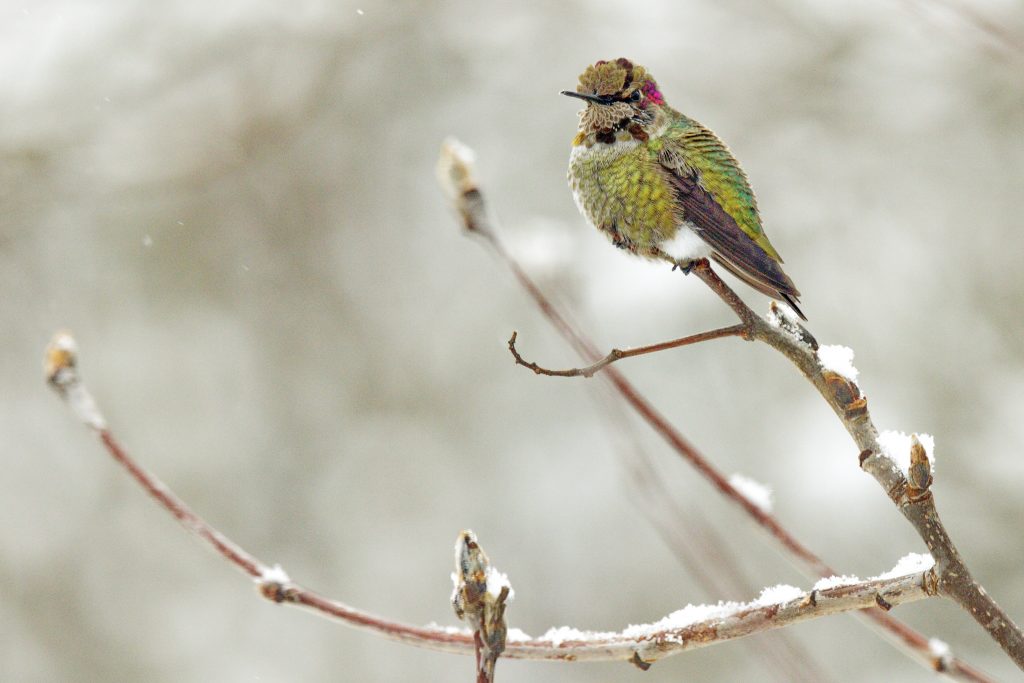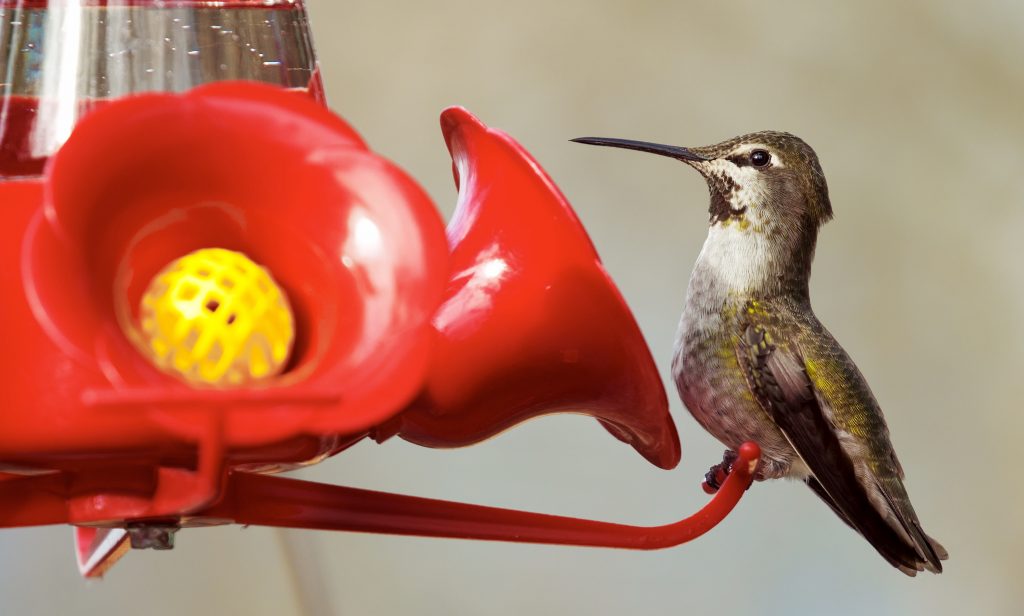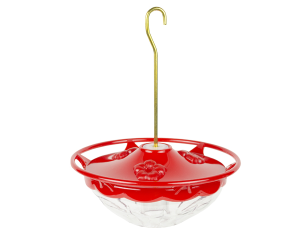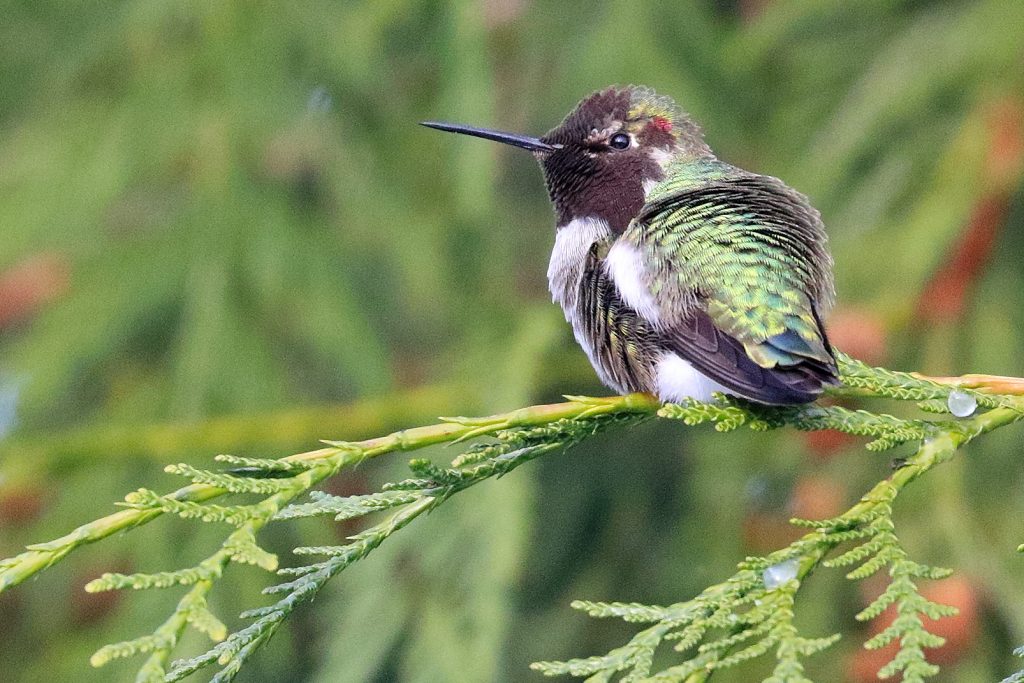Arctic Outflow Impacts Hummingbirds
Posted December 29, 2021 by Sasha, Wildlife Technician
The Arctic outflow has impacted wildlife dramatically this season! With a record-breaking drop in temperature across the Lower Mainland, hummingbirds are coming into Wildlife Rescue Association (WRA) in record numbers with cold-induced injuries.
Common winter injuries include frostbitten and damaged tongues, defensive injuries from fighting rivals for access to limited food supplies, hypothermia (frozen to feeders or other structures, and dropped to the ground), and hypoglycemia (low blood sugar, from not consuming enough calories).
Fortunately, many of these injuries can be prevented through proper feeder care.
Article Content:

How To Help Prevent These Injuries:
- Make sure the entrance/channel to the feeding tubes on the feeders are not frozen
- This is the area where the hummingbirds are becoming injured most frequently (shown below, yellow ports in photo)

- Choose a dish-style feeder (shown below) to allow for easier heating

- Keep your feeders free of ice-crystals
- Create a warming zone by sheltering your feeder from wind and snow
- Avoid feeders with exposed metal parts during sub-zero temperatures
- Do not remove the bird from the feeder if any body part is frozen to it (see instructions below).
- Keep your feeder clean!
- Put up more feeders in multiple locations.; this allows for the birds to spread out and gives more opportunity for manybirds to use them — out of sight from another feeder is best!
- Do not place more feeders up if you cannot maintain them properly. Putting up one feeder is a commitment but putting up many can be a part-time job! Make sure you have the resources to maintain the feeders properly.
How to Safely Transport a Hummingbird:
Preparation:
- Find a small box or container with tiny air holes and a lid. Place a low pile towel or paper towel in the bottom of the container.
- Preheat an indoor space away from pets, children and noise. Dimly lit or dark preferred.
Securing the animal:
- Bring the container to where the animal is located.
- After assessing and safely removing the animal from its location (see below for tips on assessment and removal) place the animal in the container, cover it securely and bring to the space you have prepared. Do not peek in the container which is very stressful for a tiny hummingbird!
Waiting to transport:
- You may need to wait for the rescue centre to open the next day, or for a friend, family member, or volunteer to transport the animal for you.
- While waiting, keep the bird quiet and warm and offer a feeder (in this situation only). Ensure the feeder is secure and does not fall, spill, or soil the bird.
- Ensure the bird can access the feeder by either rolling up a towel for it to perch next to the feeder or placing the bird on the feeder if it is more alert.
- NEVER place an open saucer, cup or other containers of sugar water in the box, as this syrup is highly likely to contaminate the feathers of the bird.
Transportation:
Once you are ready and available to transport the animal,
- REMOVE the feeder which could soil or injure the animal during transport.
- Make sure the box is closed tightly, place one hand on the bottom and one on the top of the container while carrying.
- NO PEEKING. If the bird is in a state of distress, it may use adrenaline to take any opportunity to escape the container. Trained staff and volunteers will assess the animal upon arrival at Wildlife Rescue.
- While driving to Wildlife Rescue please keep the heat on, leave the windows closed, turn off the radio, and keep the car as quiet as possible. Try to make sure the box is level and secured in place.
Arrival:
- If you called ahead, you may have specific instructions when you arrive onsite. If not, there should be a staff or volunteer at admissions to help you.
- Again, do not peek in the container to prevent more stress or escape! We would hate to have the animal escape when it is so close to getting the medical attention it needs. Trained Wildlife Technicians and Veterinarians will oversee the animal’s care and treatment.
Signs Of Distress or Injury & What To Do:
- Hummingbird Still or Frozen in Place – The bird could be in torpor or in distress (See below for more details on Torpor)
- Assess if a body part is stuck to the feeder.
- If stuck:
- Carefully drizzle tepid water on the specific area of the bird that is stuck/attached to the feeder
- Allow the bird to naturally pull itself away from the surface, as we do not want to use any force to remove
- If the tongue is awkwardly stuck and difficult to loosen with tepid water, move the bird and feeder to a warm indoor location to let the surface thaw as quickly as possible.
- Bring any bird that has been frozen to a surface to WRA for care.
- Passing Out – The bird lands on the feeder, then after eating, it passes out from the cold and falls in the snow.
- Assess the location:
- If it is on the ground, -bring the bird into WRA immediately.
- If it is perched on a high surface and the animal looks normal but sleepy, the bird may be in torpor. Monitor closely to assess if its disposition changes. During the daytime, hummingbirds feed frequently, so after a short period, you should see if flying and feeding. If the bird does not wake to feed please bring the bird to WRA immediately. If you need help assessing the bird’s behaviour please contact our Support Centre.
- Tongue sticking out – if it does not retract back into the mouth it may be a sign of severe injury.
- Their tongues are extremely sensitive to disease and frostbite
- This is a time-sensitive injury and the animal needs treatment and warmth right away.
- Bring the bird to WRA immediately.
- Hummingbird is in my house – If the hummingbird is in your house, you can lure it towards an exit with a hummingbird feeder or play sounds of a hummingbird from your phone drawing it to the door. This will require patience and commitment.
- Hummingbird struck my window – Use a towel to pick up the bird, place in a box with air holes, and bring to Wildlife Rescue as soon as possible. Window strikes can cause non-visible injuries, so we need to do a health check.
- Hummingbird caught by a cat – Cats carry bacteria in their claws and mouth that are fatal to birds. You may not notice the injuries as their teeth and claws are so sharp that cuts are not visible and can be as small as a needle prick. Visible injury or not, all birds that are caught by cats require medical treatment to prevent infection and death.
Read more about cat attacks here >
- If you suspect or have proof of your cat catching a bird bring the bird to WRA immediately for assessment and treatment
Prevent Feeders from Freezing
There are countless ways to prevent feeders from freezing. Across social media, there are many sources of creative inspiration to keep feeders from freezing along with store-bought hummingbird warmers which also work. Whichever technique you choose please remember these guidelines:
- Purchase or make a feeder heater to use when temperatures drop below zero
- Get a couple of feeders, keep one inside and alternate them when the ice starts to form.
- Keep your feeders clean – change out the solution and thoroughly scrub the feeder every few days at minimum
- Use a plastic feeder with no metal parts
- Create a warming zone, protected from wind and snow
- Remember that the most important part of the feeder to keep liquid (thawed) is the entrance/channel to the feeding tubes; this is where the tongue injuries occur when they freeze to the feeder

What is the Best Food for Hummingbirds?
A simple mixture of refined, white table sugar dissolved in boiled water is sufficient. The standard mixture is ¼ cup sugar to 1 cup water.
Make sure the mixture cools to room temperature before you “serve” it to your avian guests. If you have refrigerated a large batch of sugar water, warm to room temperature before serving.
Avoid staining the sugar water with red food colouring. Hummingbirds are attracted by the red colours of the feeder itself, not the nectar inside.
How do I keep hummingbird feeders safe and clean for birds?
Since sugar can ferment, it is important to replace hummingbird feeders once every day or every other day and give the feeder a thorough clean. Never let a feeder sit out for more than three days.
The best size hummingbird feeder for you is one that naturally empties every day or two. Because hummingbirds are territorial, it is also better to have several small feeders than one large feeder that may not empty in time. If you are unable to practice cleaning and hygiene for your feeder please reconsider your efforts. Feeders often cause hummingbird death through bacterial and fungal infections if not maintained properly.

How can I keep ants and other pests away from my feeder?
Choosing a well-built feeder is the best way to avoid pests. Saucer designs and feeders with built-in moats do a good job of keeping away unwanted bugs like bees and ants. Avoid yellow bee guards because the yellow might attract bees.
If the perches are large enough, you may get other birds like orioles and Downy Woodpeckers. If you live in an area with bears, that may also be a problem.
What is torpor?
Hummingbirds don’t hibernate in the traditional sense, but they can go into an energy-saving mode called “torpor” on cold winter nights. Torpor is a deep sleep where an animal decreases its metabolic rate by as much as 95%. By doing this, the hummingbird consumes less energy than it would if it were awake. The lowered metabolic rate also causes a lowered body temperature.
A torpid state allows them to conserve energy to survive lower temperatures faced in the winter when food sources are scarce. They also can change their diets in the winter to eat more insects when nectar flow is not available through feeders and natural sources.
During this state, hummingbirds are vulnerable to predator attacks. Please supervise any pets outside to prevent injuries. If the bird has it tongue sticking out while in torpor it is a sign of distress. Bring the bird to WRA immediately.
Learn more about winter hummingbirds and torpor here >
Hummingbird in distress? Who to call:
Hummingbirds found on the ground need help. Other signs of distress include weakness, soiled feathers, tongue hanging out, and obvious injuries. Please contact our Support Centre if you find a hummingbird displaying one or more of these signs.
Share this with friends and family:
Posted in Education, Resources
Tags: annas hummingbird, bc hummingbirds, bc winter, hummingbird, hummingbird feeders, winter, winter birds




